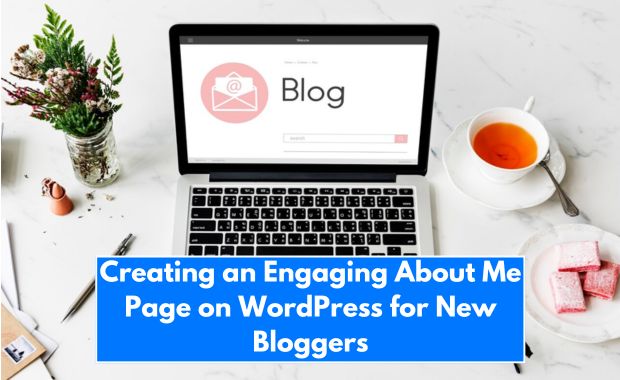An engaging and optimized “About Me” page is crucial for any new blogger. This page serves as your introduction to readers, sets the tone for your brand, and builds trust. In this guide, we’ll walk you through how to create an “About Me” page that is not only compelling for your audience but also optimized for search engines using NLP (Natural Language Processing) techniques. By the end, you’ll have a balanced page that ranks high and resonates well with readers.

Why an “About Me” Page Matters
Importance for Readers
- Builds Trust: Readers want to know the person behind the blog.
- Establishes Connection: A personal story helps forge a bond with your audience.
- Sets Expectations: Clarifies what readers can expect from your blog.
Importance for SEO
- Keyword Opportunities: Include relevant keywords to boost your site’s visibility.
- Engagement Metrics: A well-crafted page keeps readers engaged longer, improving bounce rates.
- Internal Linking: Directs users to other important sections of your blog.
Elements of a Great “About Me” Page
| Element | Purpose | Examples |
|---|---|---|
| Compelling Headline | Captures attention and encourages further reading. | “Hi, I’m [Your Name] — Helping You [Specific Goal].” |
| Personal Story | Builds authenticity and helps readers relate. | “I started this blog to share my journey of [Topic/Experience].” |
| Your Mission | Highlights your blog’s purpose and value to readers. | “My mission is to [Specific Mission or Value Proposition].” |
| Call-to-Action (CTA) | Encourages readers to take the next step, like subscribing or contacting you. | “Subscribe to my newsletter to stay updated on [Topic/Content].” |
| Visual Elements | Breaks up text and adds a personal touch. | Include high-quality photos, videos, or infographics that represent your journey or mission. |
| SEO Keywords | Helps search engines understand your page’s content. | Use terms like “About Me for [Topic] Bloggers” or “[Niche] Blogger Introduction.” |
Step-by-Step Guide to Creating Your “About Me” Page
1. Write a Captivating Headline
Your headline is the first thing visitors will see. Make it attention-grabbing and reflective of your blog’s purpose.
Examples:
- “Welcome! I’m [Your Name], Your Guide to [Specific Topic/Niche]”
- “Hi, I’m [Your Name], Sharing Stories and Tips on [Blog Topic]”
2. Start with Your Personal Story
Your story should answer these questions:
- Who are you?
- Why did you start blogging?
- What makes your journey unique?
Example:
“My name is [Your Name], and I’m passionate about [Topic/Niche]. My blogging journey began in [Year] when I faced [Problem or Challenge]. Through trial and error, I discovered [Solution or Insight], which inspired me to start this blog.”
3. Highlight Your Mission and Purpose
Make it clear why your blog exists and what value it provides to readers.
Template:
“This blog is dedicated to [Audience/Niche]. My goal is to help [Audience] by providing [Content/Value]. Whether you’re new to [Topic] or looking to deepen your understanding, I’m here to guide you every step of the way.”
4. Add Visual Elements
Visuals make your page more engaging. Include:
- Photos: A friendly headshot to connect with readers.
- Videos: A quick introduction or behind-the-scenes look.
- Infographics: Showcase your blogging milestones or expertise.
5. Use Call-to-Actions (CTAs)
Encourage readers to take actions such as:
- Subscribing to your newsletter.
- Following you on social media.
- Exploring other parts of your blog.
Example:
“Want to stay updated on the latest tips and insights? Subscribe to my newsletter here!“
6. Optimize for NLP
How NLP Improves Your “About Me” Page
- Semantic Keywords: Use terms and phrases that naturally align with your niche.
- Entity Recognition: Highlight key topics and personal details that add context.
- Readability: Keep sentences concise and easy to understand.
Tips for Optimization:
- Include LSI (Latent Semantic Indexing) keywords like “personal blogging journey,” “[Niche] tips,” and “meet the blogger.”
- Use headings and subheadings to structure content for better readability.
- Incorporate FAQs to address common reader questions.
Example “About Me” Page Layout
Headline
“Hi, I’m [Your Name] — Helping You [Achieve Goal]!”
Section 1: Introduction
Welcome to my blog! My name is [Your Name], and I’m here to share my journey and insights about [Niche/Topic].
Section 2: Personal Story
I started this blog in [Year] because [Personal Story/Reason]. Over the years, I’ve learned so much about [Topic] and am excited to share my knowledge with you.
Section 3: Mission and Value
My mission is simple: to help [Audience/Niche] by providing [Content/Value].
Section 4: Call-to-Action
Ready to join me on this journey? Subscribe here to never miss an update!
NLP-Optimized FAQs
Q1: What is the purpose of this blog?
This blog is dedicated to helping [Audience/Niche] with [Value/Content].
Q2: Who is [Your Name]?
I’m [Your Name], a [Role/Passion] who started this blog to share insights about [Topic].
Q3: How can I connect with you?
You can reach me via [Contact Form] or follow me on [Social Media Links].
Final Checklist for Your “About Me” Page
| Task | Status |
| Include a captivating headline | ☑ Completed |
| Share a compelling story | ☑ Completed |
| Highlight your mission | ☑ Completed |
| Add visual elements | ☑ Completed |
| Include a clear CTA | ☑ Completed |
| Optimize with NLP | ☑ Completed |
By following this guide, you’ll create an “About Me” page that captivates readers while improving your blog’s SEO. Don’t underestimate the power of this page — it’s your chance to make a lasting first impression!